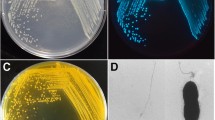Abstract
Vibrio ordalii sp. nov. is the name proposed for the bacterium previously designated asV. anguillarum biotype 2. The change in the classification of this fish pathogen is based on differences between the classicalV. anguillarum andV. ordalii in cultural and biochemical characteristics, and in deoxyribonucleic acid (DNA) sequence relatedness. Phenotypically,V. ordalii was distinguishable fromV. anguillarum based on: negative Voges-Proskauer reaction; negative reaction with arginine in Moeller's medium; negative Simmons' and Christensen's citrate test; negative ONPG test; failure to hydrolyze starch; failure to show lipase activity; inability to grow at 37°C; and failure to ferment cellobiose, glycerol, sorbitol, and trehalose. Genotypically, strain ofV. ordalii formed a highly conserved DNA homology group which showed 83 to 100% within-group homology and only 58 to 69% relatedness toV. anguillarum. In contrast, theV. anguillarum strains tested showed greater than 70% withingroup homology and 53 to 67% relatedness toV. ordalii. NeitherV. ordalii norV. anguillarum were related toV. parahaemolyticus orV. alginolyticus. The proposed type strain (holotype) ofV. ordalii is ATCC 33509 (=DF3K=Dom F3 kid).
Similar content being viewed by others
Literature Cited
Anacker, R. L., Ordal, E. J. 1959. Studies on the myxobacteriumChrondrococcus columnaris. I. Serological typing. Journal of Bacteriology78:25–32.
Anderson, R. S., Ordal, E. J. 1972. Deoxyribonucleic acid relationships among marine vibrios. Journal of Bacteriology109:696–706.
Barritt, M. M. 1936. The intensification of the Voges-Proskauer reaction by the addition of alpha-naphol. Journal of Pathology and Bacteriology42:441–454.
Baumann, P., Bang, S. S., Baumann, L. 1978. Phenotypic characterization ofBeneckea anguillara biotypes I and II. Current Microbiology1:85–88.
Baumann, P., Baumann, L., Bang, S. S., Woolkalis, M. J. (1980). Reevaluation of the taxonomy ofVibrio, Beneckea, andPhotobacterium: Abolition of the genusBeneckea. Current Microbiology4:127–132.
Bergman, A. M. 1909. Die rote Beulenkrankheit des Aals. Berichte aus der Königlichen Bayerischen biologischen Versuchsstation2:10–54.
Canestrini, G. 1893. La malattia dominante delle anguille. Atti Instituto delle Scienze7:809–814.
Crosa, J. H. 1980. A plasmid associated with virulence in the marine fish pathogenVibrio anguillarum specifies an ironsequestering system. Nature (London).284:566–568.
Crosa, J. H., Brenner, D. J., Falkow, S. 1973. Use of a single-strand specific nuclease for analysis of bacterial and plasmid deoxyribonucleic acid homo- and heteroduplexes. Journal of Bacteriology115:904–911.
Crosa, J. H., Hodges, L. L., Schiewe, M. H. 1980. Curing of a plasmid is correlated with an attenuation of virulence in the marine fish pathogenVibrio anguillarum. Infection and Immunity27:897–902.
Crosa, J. H., Schiewe, M. H., Falkow, S. 1977. Evidence for a plasmid contribution to the virulence of the marine fish pathogenVibrio anguillarum. Infection and Immunity18:509–513.
Edwards, R. R., Ewing, W. H. 1972. Identification of Enterobacteriaceae. Minneapolis, Minnesota: Burgess.
Evelyn, T. P. T. 1971. First records of vibriosis in Pacific salmon cultured in Canada, and taxonomic status of the responsible bacterium,Vibrio anguillarum. Journal of the Fisheries Research Board of Canada28:517–525.
Ezura, Y., Tajima, K., Yoshimizu, M., Kimura, T. 1980. Studies on the taxonomy and serology of causative organisms of fish vibriosis. Fish Pathology14:167–179.
Gould, R. W., Antipa, R., Amend, D. F. 1979. Immersion vaccination of sockeye salmon (Oncorhynchus nerka) with two pathogenic strains ofVibrio anguillarum. Journal of the Fisheries Research Board of Canada.36:222–225.
Harrell, L. W., Novotny, A. J., Schiewe, M. H., Hodgins, H. O. 1976. Isolation and description of two vibrios pathogenic to Pacific salmon in Puget Sound, Washington. Fisheries Bulletin74:447–449.
Kovacs, N. 1956. Identification ofPseudomonas pyocyanea by the oxidase reaction. Nature (London)178:703.
Le Minor, L., Ben Hamida, F. 1962. Advantages de la recherche de la beta-galactosidase sur celle de la fermentation du lactose en milieu complexe dans le diagnostic bactériologique, en particulier des Enterobacteriaceae. Annales de l'Institut Pasteur102:109–118.
Marmur, J., Doty, P. 1962. Determination of the base composition of deoxyribonucleic acid from its thermal denaturation temperature. Journal of Molecular Biology5:109–118.
Ohnishi, K., Muroga, K. 1976.Vibrio sp. as a cause of disease in rainbow trout cultured in Japan. I. Biochemical characteristics. Fish Pathology11:159–165.
Ohnishi, K., Muroga, K. 1977.Vibrio sp. as a cause of disease in rainbow trout cultured in Japan. II. Physiological characteristics and pathogenicity. Fish Pathology12:51–55.
Ransom, D. P. 1978. Bacteriologic, immunologic, and pathologic studies ofVibrio sp. pathogenic to salmonids. Ph.D. thesis, Oregon State University, Corvallis, Oregon.
Reichelt, J. L., Baumann, P., Baumann L. 1976. Study of genetic relationships among marine species of the generaBeneckea andPhotobacterium by means of in vitro DNA/DNA hybridization. Archives of Microbiology110:101–120.
Schiewe, M. H. 1980. Studies on the pathogenesis of vibriosis in salmonid fish. Ph.D. thesis, University of Washington, Seattle, Washington.
Schiewe, M. H., Crosa, J. H. 1981. Molecular characterization ofVibrio anguillarum biotype 2. Canadian Journal of Microbiology27:1011–1018.
Schiewe, M. H., Crosa, J. H., Ordal, E. J. 1977. Deoxyribonucleic acid relationships among marine vibrios pathogenic to fish. Canadian Journal of Microbiology23:954–958.
Schiewe, M. H., Hodgins, H. O. 1977. Specificity of protection induced in coho salmon (Oncorhynchus kisutch) by heat-treated components of two pathogenic vibrios. Journal of the Fisheries Research Board of Canada34:1026–1028.
Shewan, J. M., Hodgkiss, W. H., Liston, J. 1954. A method for rapid differentiation of certain non-pathologenic asporogenous bacilli. Nature (London)173:208–209.
Staley, T. E., Colwell, R. R. 1973. Polynucleotide sequence relationships among Japanese and American strains ofVibrio parahaemolyticus. Journal of Bacteriology114:916–927.




